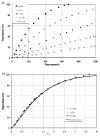A mathematical model of evolving mechanical properties of intraluminal thrombus
- PMID: 20164633
- PMCID: PMC2904399
- DOI: 10.3233/BIR-2009-0556
A mathematical model of evolving mechanical properties of intraluminal thrombus
Abstract
Quantifying mechanical properties of blood clots is fundamental to understanding many aspects of cardiovascular disease and its treatment. Nevertheless, there has been little attention to quantifying the evolving composition, structure and properties when a clot transforms from an initial fibrin-based mesh to a predominantly collagenous mass. Although more data are needed to formulate a complete mathematical model of the evolution of clot properties, we propose a general constrained mixture model based on diverse data available from in vitro tests on fibrinogenesis, the stiffness of fibrin gels, and fibrinolysis as well as histological and mechanical data from clots retrieved from patients at surgery or autopsy. In particular, albeit resulting from complex kinetics involving many clotting factors, we show that the rapid (minutes) in vitro production of fibrin from fibrinogen can be modeled well by an Avrami-type relation and similarly that the fast (tens of minutes) in vitro degradation of fibrin in response to different concentrations of plasmin can be captured via a single "master function" parameterized by appropriate half-times that can be inferred from laboratory or clinical data. Accounting simultaneously for the production and removal of fibrin as well as chemo-mechano-stimulated production of fibrillar collagens yields predictions of changing mass fractions and bulk mechanical properties that correspond well to experimentally available data. Constrained mixture models thus hold considerable promise for modeling the biomechanics of clot evolution and can guide the design and interpretation of needed experiments and stress analyses.
Figures








References
-
- Adolph R, Vorp DA, Steed DL, Webster MW, Kameneva MV, Watkins SC. Cellular content and permeability of intraluminal thrombus in abdominal aortic aneurysm. J Vasc Surg. 1997;25:916–926. - PubMed
-
- Alberts B, Johnson A, Lewis J, Raff M, Roberts K, Walter P. Molecular biology of the cell. New York: Garland Science; 2002.
-
- Anand M, Rajagopal K, Rajagopal KR. A model for the formation, growth, and lysis of clots in quiescent plasma. A comparison between the effects of antithrombin III deficiency and protein C deficiency. J Theor Biol. 2008;253:725–38. - PubMed
-
- Baek S, Rajagopal KR, Humphrey JD. A theoretical model of enlarging intracranial fusiform aneurysms. J Biomech Eng. 2006 Feb;128:142–149. - PubMed
Publication types
MeSH terms
Substances
Grants and funding
LinkOut - more resources
Full Text Sources
Other Literature Sources
Medical

